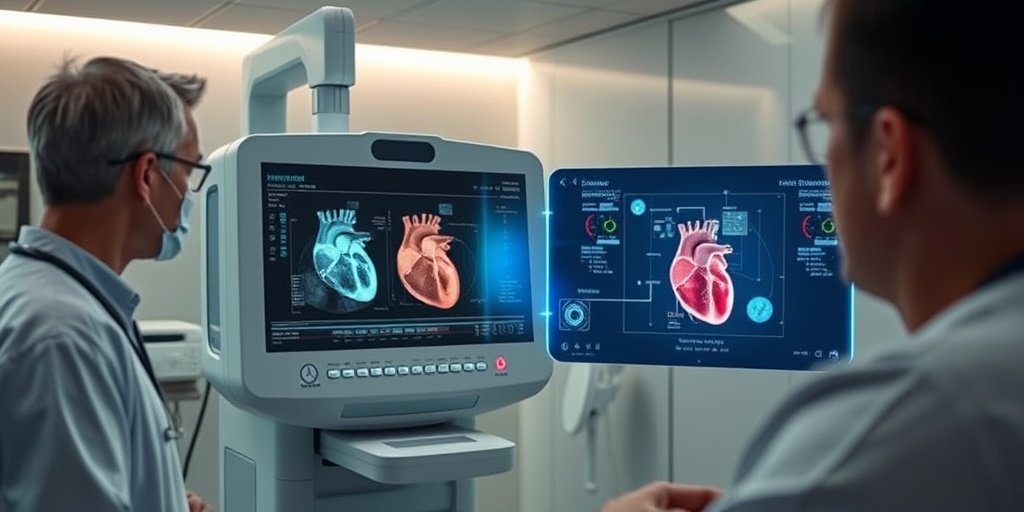⚡ Quick Summary
This study developed a deep learning framework for the automated detection and grading of aortic stenosis (AS) using echocardiography. The model demonstrated impressive performance with an AUC of 0.942 in detecting AS, showcasing its potential to enhance clinical workflows.
🔍 Key Details
- 📊 Dataset: 499 AS studies from 17,436 cases, including 1,996 echocardiographic views
- 🧩 Features used: Multiview and single-view echocardiographic data
- ⚙️ Technology: Deep learning algorithms for AS detection and grading
- 🏆 Performance: AUC of 0.942 for AS detection in the prospective test dataset
🔑 Key Takeaways
- 🤖 Deep learning can automate echocardiogram interpretation, improving accuracy and efficiency.
- 📈 High performance was achieved with an AUC of 0.942 for AS detection.
- 🔍 Excellent correlation between DL-graded metrics and manual measurements for various echocardiographic parameters.
- 🏅 Severe AS detection had the highest AUC of 0.976, outperforming moderate and mild AS classifications.
- 📊 Two-dimensional parasternal long-axis view yielded comparable AUCs across AS severities (0.869-0.920).
- 🌍 Study conducted across three hospitals, enhancing the robustness of the findings.
- 💡 Potential for clinical integration to streamline AS screening and grading processes.

📚 Background
Aortic stenosis (AS) is a significant valvular heart disease that can lead to serious cardiovascular complications. Traditional methods of assessing AS severity through echocardiography can be time-consuming and subject to human error. The integration of deep learning technologies into clinical practice offers a promising avenue for automating and improving the accuracy of AS assessments, potentially transforming patient care.
🗒️ Study
The study involved a comprehensive analysis of 499 AS studies, which were meticulously selected from a larger pool of 17,436 cases of patients with valvular heart diseases. The researchers developed a deep learning framework that not only classified echocardiographic views but also detected the presence of AS and assessed its severity using both multiview and single-view algorithms.
📈 Results
The deep learning model exhibited remarkable performance in detecting AS, achieving an AUC of 0.942 in the prospective test dataset. The correlation between the metrics graded by the deep learning model and manual measurements was excellent, with peak velocities and gradients showing high correlation coefficients (e.g., AV peak velocity: r=0.94; P<0.001). Notably, the model excelled in identifying severe AS, with an AUC of 0.976, significantly surpassing the performance for moderate (AUC =0.907) and mild AS (AUC =0.874).
🌍 Impact and Implications
The findings from this study have the potential to revolutionize the way aortic stenosis is screened and graded in clinical settings. By automating the interpretation of echocardiograms, healthcare professionals can enhance their diagnostic capabilities, leading to timely and accurate treatment decisions. This deep learning framework could significantly improve patient outcomes and streamline clinical workflows, making it a valuable tool in the management of valvular heart diseases.
🔮 Conclusion
This study highlights the transformative potential of deep learning in the field of echocardiography, particularly for the detection and grading of aortic stenosis. The impressive performance metrics indicate that such technologies could play a crucial role in enhancing clinical efficiency and accuracy. Continued research and development in this area are essential to fully realize the benefits of AI in healthcare.
💬 Your comments
What are your thoughts on the integration of deep learning in echocardiography? We would love to hear your insights! 💬 Share your comments below or connect with us on social media:
Deep learning-assisted aortic stenosis detection and grading based on multiview versus single-view echocardiography.
Abstract
BACKGROUND: Advances in deep learning (DL) have shown promise in automating echocardiogram interpretation, thereby enhancing accuracy and efficiency in clinical practice. However, a fully automated pipeline for aortic stenosis (AS) analysis remains largely unexplored. This study aimed to develop a DL framework to streamline clinical AS assessment.
METHODS: A total of 499 AS studies (1,996 echocardiographic view) were selected from 17,436 cases of patients with valvular heart diseases (VHDs) obtained from three hospitals to form training (n=302), validation (n=76), and internal testing (n=121) datasets, while a prospectively collected set of 3,278 consecutive echocardiograms served as a real-world test data set. The DL framework automatically classified echocardiographic views, detected the presence of AS, and employed two algorithms to assess severity: multiview and single-view.
RESULTS: The DL model achieved high performance in AS detection in the prospective test dataset, with an area under the curve (AUC) of 0.942. The correlation between DL-graded metrics and manual measurements was excellent for aortic valve (AV) peak velocity (r=0.94; P<0.001), mean peak gradient (r=0.91; P<0.001), left ventricular outflow tract diameter (LVOTd) (r=0.81; P<0.001), AV velocity-time integral (VTI) (r=0.94; P<0.001), LVOT VTI (r=0.88; P<0.001), and AV area (r=0.87; P<0.001). Based on these metrics, the AUC of severe AS was the highest at 0.976 [95% confidence interval (CI): 0.953-1.0], significantly superior to those for moderate AS (AUC =0.907) and mild AS (AUC =0.874). The two-dimensional parasternal long-axis view method yielded comparable AUCs for all AS severities (AUC: 0.869-0.920).
CONCLUSIONS: The proposed DL algorithm has the potential to automate and enhance the efficiency of clinical workflows for AS screening and grading in echocardiography.
Author: [‘Yang F’, ‘Zhang Y’, ‘Gao Y’, ‘Wang B’, ‘Lin X’, ‘Chen X’, ‘Wang Q’, ‘Zhang M’, ‘Li X’, ‘Liu B’, ‘Zhang P’, ‘He K’, ‘Zhang L’]
Journal: Quant Imaging Med Surg
Citation: Yang F, et al. Deep learning-assisted aortic stenosis detection and grading based on multiview versus single-view echocardiography. Deep learning-assisted aortic stenosis detection and grading based on multiview versus single-view echocardiography. 2025; 15:11192-11204. doi: 10.21037/qims-2025-415